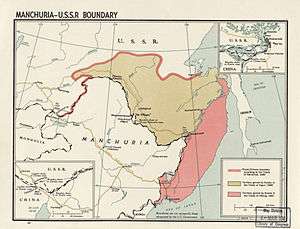Treaty of Aigun
The Treaty of Aigun (Russian: Айгунский договор; traditional Chinese: 璦琿條約; simplified Chinese: 瑷珲条约; pinyin: Àihún Tiáoyuē) was an 1858 unequal treaty between the Russian Empire, and the empire of the Qing Dynasty, the Manchu rulers of China, that established much of the modern border between the Russian Far East and Manchuria (the original homeland of the Manchu people and the Qing Dynasty), which is now known as Northeast China.[1] It reversed the Treaty of Nerchinsk (1689) by transferring the land between the Stanovoy Range and the Amur River from China (Qing Empire) to the Russian Empire. Russia received over 600,000 square kilometres (231,660 sq mi) from Manchuria.[2][3]

Background
Since the reign of Catherine the Great (1762 – 1796), Russia had desired to become a naval power in the Pacific. It did so by annexing Kamchatka Peninsula and establishing the naval outpost of Petropavlovsk-Kamchatsky in 1740, naval outposts in Russian Alaska and near the River Amur watershed, encouraging Russians to go there and settle, and slowly developing a strong military presence in the Amur region. China never governed that region effectively or conducted territorial surveys, and these Russian advances went unnoticed.
From 1850 to 1864, China was heavily fighting the Taiping Rebellion, and Governor-General of the Far East Nikolay Muraviev camped tens of thousands of troops on the borders of Mongolia and Manchuria, preparing to make legal Russian de facto control over the Amur from past settlement.[2] Muraviev seized the opportunity when it was clear that China was losing the Second Opium War, and threatened China with a war on a second front.[3] The Qing Dynasty agreed to enter negotiations with Russia.[2]
Signing
The Russian representative Nikolay Muravyov and the Qing representative Yishan, both military governors of the area signed the treaty on May 28, 1858, in the town of Aigun.[3]
Effects
The resulting treaty established a border between the Russian and Chinese Empires along the Amur River. (Chinese and Manchu residents of the Sixty-Four Villages East of the Heilongjiang River would be allowed to remain, under the jurisdiction of Manchu government.) The Amur, Sungari, and Ussuri rivers were to be open exclusively to both Chinese and Russian ships. The territory bounded on the west by the Ussuri, on the north by the Amur, and on the east and south by the Sea of Japan was to be jointly administered by Russia and China—a "condominium" arrangement similar to that which the British and Americans had agreed upon for the Oregon Territory in the Treaty of 1818.[2] (Russia gained sole control of this land two years later.)[4]
See also
- Convention of Peking
- Amur Acquisition
- Sino-Russian border conflicts
- Outer Manchuria
- Unequal Treaties
- Western imperialism in Asia
References
| Russian Wikisource has original text related to this article: |
| Chinese Wikisource has original text related to this article: |
- "Russia and China end 300 year old border dispute". BBC News. 1997-11-10. Retrieved 2010-08-14.
- Tzhou, Byron N (1990). China and international law: the boundary disputes. Greenwood Publishing Group. p. 47. ISBN 978-0-275-93462-0.
- Paine, SCM (2003). The Sino-Japanese War of 1894–1895: perceptions, power, and primacy. Cambridge University Press. ISBN 978-0-521-81714-1.
- Bissinger, Sally (1969-06-26). "The Sino-Soviet Border Talks". Radio Liberty research bulletin. Archived from the original on 2012-02-26. Retrieved 2010-08-14.